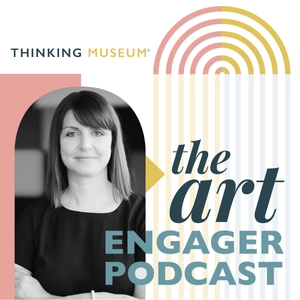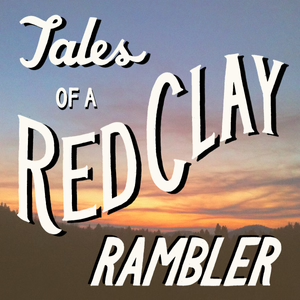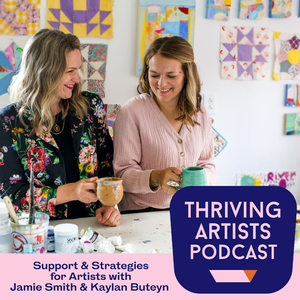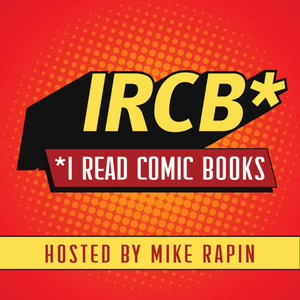
How to Look at Art (Slowly)
11/17/22 • 11 min
1 Listener
We’ve reached another milestone and in honour of 75 episodes, I’m releasing a new FREE resource today.
How to Look at Art (Slowly) shares 30+ different ways that you can look at art or objects in museums.
In today’s special episode I’m talking you through some of these different ways of looking slowly.
I'll share why it's important to slow down and look carefully, before explaining the 4 sections of the guide: Static Looking, Movement, Observation by Drawing, Observation by Writing and Viewfinders.
How to Look at Art (Slowly) is a resource that can be used by anyone.
Whether you’re going to a museum alone and would like some strategies for looking, or if you’re visiting with a friend and are on the lookout for some new ways to engage with what you’re seeing.
Likewise, if you’re an educator or guide, you can use these activities with your groups. All of the activities are coded as either solo or group activities.
These simple activities offer a framework and tools for looking at art and objects for longer.
Choose a variety of different ways to look as you move around the museum. You may want to choose activities that appeal to you or you might want to step out of your comfort zone and try something new. All of the activities will help you to see more.
Download this free guide via the link below and then listen to the episode!
LINKS
HOW TO LOOK AT ART (SLOWLY) - a free guide for looking with 30+ activities!
Join the Slow Looking Club Community on Facebook
We’ve reached another milestone and in honour of 75 episodes, I’m releasing a new FREE resource today.
How to Look at Art (Slowly) shares 30+ different ways that you can look at art or objects in museums.
In today’s special episode I’m talking you through some of these different ways of looking slowly.
I'll share why it's important to slow down and look carefully, before explaining the 4 sections of the guide: Static Looking, Movement, Observation by Drawing, Observation by Writing and Viewfinders.
How to Look at Art (Slowly) is a resource that can be used by anyone.
Whether you’re going to a museum alone and would like some strategies for looking, or if you’re visiting with a friend and are on the lookout for some new ways to engage with what you’re seeing.
Likewise, if you’re an educator or guide, you can use these activities with your groups. All of the activities are coded as either solo or group activities.
These simple activities offer a framework and tools for looking at art and objects for longer.
Choose a variety of different ways to look as you move around the museum. You may want to choose activities that appeal to you or you might want to step out of your comfort zone and try something new. All of the activities will help you to see more.
Download this free guide via the link below and then listen to the episode!
LINKS
HOW TO LOOK AT ART (SLOWLY) - a free guide for looking with 30+ activities!
Join the Slow Looking Club Community on Facebook
Previous Episode

How to enjoy art (without knowing anything about it) with Ben Street
Today I’m chatting to Ben Street about his new book 'How to Enjoy Art: A Guide for Everyone'. We’re talking about how we can enjoy art without needing to know anything about it.
Ben Street is an author, educator and art historian. He’s also been a school teacher and museum educator. He’s a writer of interpretation for museums and exhibitions and a writer of art criticism. He’s an academic and he writes books - “How to Enjoy Art: A Guide for Everyone” (Yale) and “How to be an Art Rebel” (Thames and Hudson) are out now.
In our chat today, we talk about the values that guide Ben’s work and how he’s passionate about us all being able to enjoy art without needing any specialist knowledge.
We talk about slow looking and open questioning and how we can approach art with the tools we already have within us.
We focus on why looking is so important to the art experience, we explore ways in which we can look for longer and we talk about how scale and space affects how we relate to art.
We discuss why we rarely feel we need to read about a piece of music before we listen to it, but with art, we feel we need to know something about it to look at it. And that artworks come ‘wrapped in text’ before we can even get to them. Why is this? How has this come about?
This chat is jam-packed with ideas and inspiration for you. Here’s my chat with Ben. Enjoy!
LINKS
Join the Slow Looking Club Community on Facebook
Ben Street -
Books - How to Enjoy Art; How to be an Art Rebel
Next Episode

The joy of engaging with objects with Dr Alex Woodall
I’m really happy to be talking to Dr Alex Woodall about her wonderful work with objects. We’re talking about how the joys of working with objects creatively. We’re exploring how you can use objects to spark all sorts of connections, associations and fun in the museum and beyond...
Dr Alex Woodall is a museum professional and academic, inspired by the creative use of objects and rummaging in stores.
She has 20 years’ experience working in learning, interpretation and exhibition management and leadership roles, including at Sheffield Museums, Manchester Art Gallery, the Royal Armouries in Leeds and the Sainsbury Centre at the University of East Anglia.
She is currently Programme Director for the Postgraduate Creative and Cultural Industries Management degree at the University of Sheffield, where she teaches a large international cohort about museum management.
In our chat today, we talk about the joys of working with objects creatively. Alex shares how her love for objects started when she was very small rummaging through her dad’s ‘museum’ full of amazing finds that he’d dug up in the garden - rocks and fossils and clay pipes and so on. And how that developed into a career-long fascination with all kinds of objects.
We talk about what objects do, how we can use them and what we can get out of working with objects.
Alex tells us what an object dialogue box is and how you can use objects to spark all sorts of connections, associations and fun in the museum. She takes us through a wonderful activity that I did with her at the ICOM CECA conference in Denmark recently that helps us to notice more details and find stuff in museums that we would normally overlook.
We also talk about how we can use objects to inspire more creativity and imagination organisations in for example meetings, in teams, programming, brainstorming etc. And she shares two wonderful books to read if you’re as fascinated by objects as we both are.
This is a delightful chat about creating joyful engaging experiences with objects -Enjoy!
LINKSHOW TO LOOK AT ART (SLOWLY) - a free guide for looking with 30+ activities!
Join the Slow Looking Club Community on Facebook
https://www.kettlesyard.co.uk/
Karl and Kimberley Foster - Object Dialogue Boxes https://www.sorhed.com/
http://www.marymaryquitecontrary.org.uk/
Books mentioned:
Sandra Dudley (2010) Museum Materialities: https://www.routledge.com/Museum-Materialities-Objects-Engagements-Interpretations/Dudley/p/book/9780415492188
Pablo Neruda (1994) Odes to Common Things: https://www.amazon.co.uk/Common-Things-First-Pablo-Neruda/dp/B0058WGC84
Written by Alex Woodall:
- Woodall A (2020) 'Storehouses of Unimagined Treasures': Delightful Rummaging and Artists' Responses to 'Unloved' Collections In Woodham A, Hess A & Smith R (Ed.), Emotion, Care, and Engagement in Museums: Interventions in Unloved Collections Arc Humanities Press View this article in WRRO
- Woodall A (2015) Rummaging as a Strategy for Creative Thinking and Imaginative Engagement in Higher Education In Chatterjee H & Hannan L (Ed.), Engaging the Senses: Object-Based Learning in Higher Education (pp. 133-155). Surrey: Ashgate. View this article in WRRO
- Woodall A (2015) Object Dialogue Boxes and Unknowing In Farnell G (Ed.), Interpreting the Art Museum (pp. 366-377). MuseumsEtc
If you like this episode you’ll love
Episode Comments
Generate a badge
Get a badge for your website that links back to this episode
<a href="https://goodpods.com/podcasts/the-art-engager-245896/how-to-look-at-art-slowly-27871600"> <img src="https://storage.googleapis.com/goodpods-images-bucket/badges/generic-badge-1.svg" alt="listen to how to look at art (slowly) on goodpods" style="width: 225px" /> </a>
Copy




